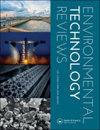E-waste recycling and public exposure to organic compounds in developing countries: a review of recycling practices and toxicity levels in Ghana
Q1 Environmental Science
引用次数: 14
Abstract
ABSTRACT This paper reviews e-waste practices and aggregates the toxicity levels of organic compounds in different environmental media and human body fluids resulting from e-waste recycling activities in Ghana. Literature was searched from three academic databases (Science Direct, SpringerLink and PUBMED). Research articles published in English from 2010 to 2018 were selected in addition to reports of country studies. In all, 13 documents passed the inclusion criteria. E-waste recycling practices in Ghana were found to be mainly rudimentary. The major organic contaminants found in soils, air, sediments, food and body fluids of people exposed to e-waste recycling activities are PAHs, PCBs, Dioxin-like PCBs, PCDD/Fs, PBDD/Fs and PBDEs. The concentration of PCBs in the blood of e-waste workers and breast milk of nursing mothers at the recycling areas were respectively 0.082 µg/g (blood) and 3.64 ng/g lipid wt (breast milk). PAH was 3.94 µg/g creatinine in the urine of e-waste workers and 4,822 ng/g (median) in the soils at open burning areas. PCDD/F was 12.1 pg/g lipid base WHO2005-TEQ per year in the blood of e-waste workers and 988 pg TEQ/g in sediments of a shallow lagoon near the largest e-waste recycling site. Further studies are required to establish the levels of organic contaminants in air, water and foodstuffs at e-waste recycling sites and body burdens of children living or illegally working at e-waste recycling sites. GRAPHICAL ABSTRACT发展中国家的电子废物回收和公众接触有机化合物:加纳回收做法和毒性水平综述
摘要:本文回顾了加纳电子垃圾回收活动的实践,并汇总了不同环境介质和人体体液中有机化合物的毒性水平。文献检索来自三个学术数据库(Science Direct、SpringerLink和PUBMED)。除了国别研究报告外,还选择了2010年至2018年以英文发表的研究文章。总共有13份文件通过了纳入标准。加纳的电子垃圾回收做法主要是初级的。在土壤、空气、沉积物、食物和接触电子废物回收活动的人的体液中发现的主要有机污染物是多环芳烃、多氯联苯、二恶英类多氯联苯、多氯二苯并呋喃、多溴二苯并二恶英和多溴二醚。回收区电子垃圾工人血液和哺乳期母亲母乳中多氯联苯的浓度分别为0.082 µg/g(血液)和3.64 ng/g脂质wt(母乳)。PAH为3.94 电子垃圾处理工人和4822人尿液中的肌酸酐µg/g 露天焚烧区土壤中的ng/g(中位数)。电子废物工作人员血液中的多氯二苯并呋喃(PCDD/F)为12.1 pg/g脂质基WHO2005-TEQ,最大电子废物回收站附近浅泻湖沉积物中的多氟二苯并二恶英(PCDD/F)为988 pg/TEQ/g。需要进一步研究,以确定电子废物回收点的空气、水和食品中的有机污染物水平,以及在电子废物回收站生活或非法工作的儿童的身体负担。图形摘要
本文章由计算机程序翻译,如有差异,请以英文原文为准。
求助全文
约1分钟内获得全文
求助全文
来源期刊

Environmental Technology Reviews
Environmental Science-Water Science and Technology
CiteScore
6.90
自引率
0.00%
发文量
8
 求助内容:
求助内容: 应助结果提醒方式:
应助结果提醒方式:


